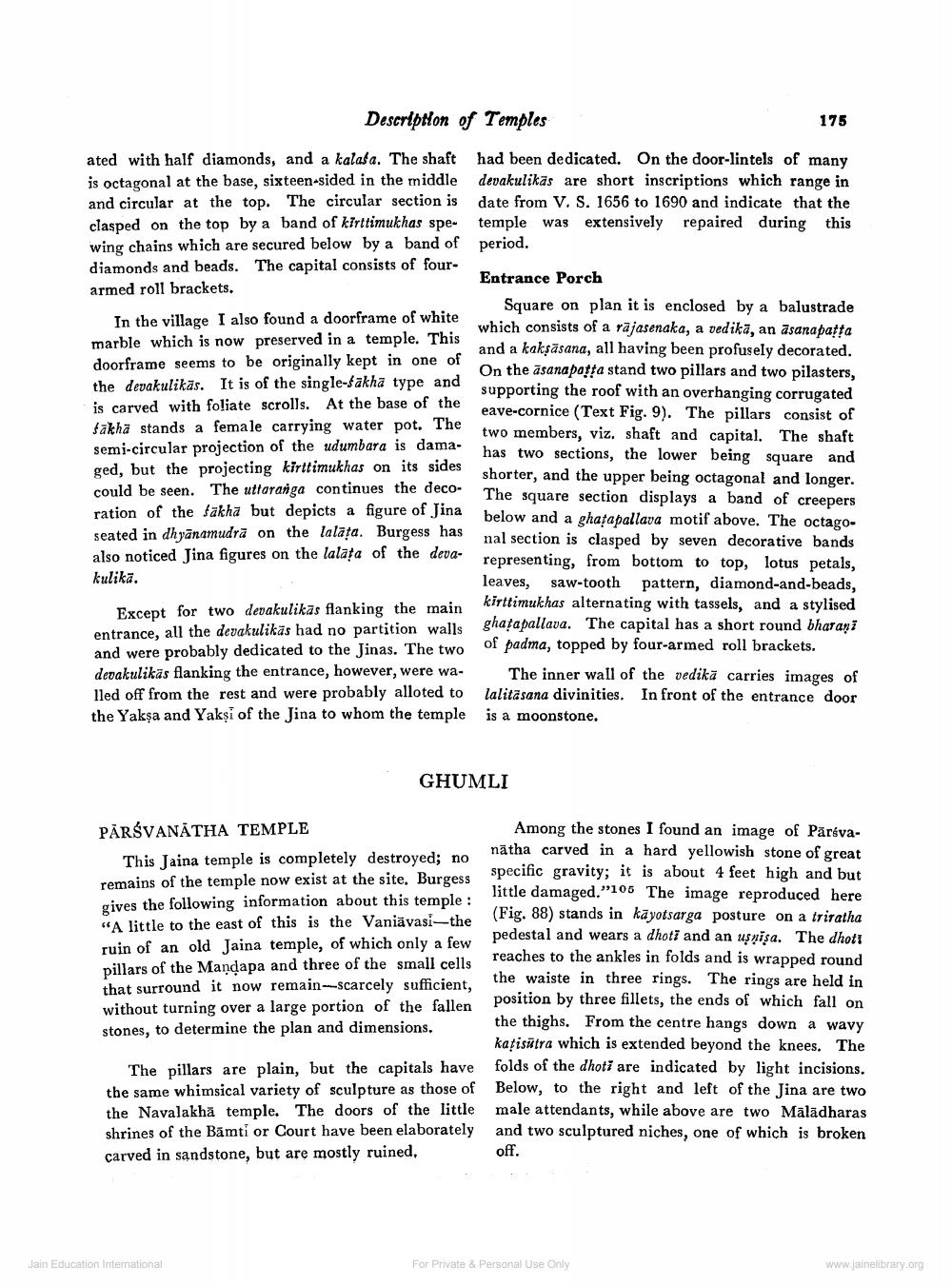________________
Description of Temples
175
ated with half diamonds, and a kalasa. The shaft had been dedicated. On the door-lintels of many is octagonal at the base, sixteen-sided in the middle devakulikās are short inscriptions which range in and circular at the top. The circular section is date from V. S. 1656 to 1690 and indicate that the clasped on the top by a band of kirttimukhas spe- temple was extensively repaired during this wing chains which are secured below by a band of period. diamonds and beads. The capital consists of four
Entrance Porch armed roll brackets.
Square on plan it is enclosed by a balustrade In the village I also found a doorframe of white
which consists of a rājasenaka, a vedika, an asanapatta marble which is now preserved in a temple. This
and a kaksāsana, all having been profusely decorated. doorframe seems to be originally kept in one of
On the asana pasta stand two pillars and two pilasters, the devakulikās. It is of the single-fakha type and
supporting the roof with an overhanging corrugated is carved with foliate scrolls. At the base of the
eave-cornice (Text Fig. 9). The pillars consist of Sākha stands a female carrying water pot. The
two members, viz. shaft and capital. The shaft semi-circular projection of the udumbara is dama
has two sections, the lower being square and ged, but the projecting kirttimukhas on its sides
shorter, and the upper being octagonal and longer. could be seen. The uttaranga continues the deco
The square section displays a band of creepers ration of the fākha but depicts a figure of Jina
below and a ghatapallava motif above. The octagoseated in dhyānamudra on the lalata. Burgess has
nal section is clasped by seven decorative bands also noticed Jina figures on the lalata of the deva
representing, from bottom to top, lotus petals, kulika.
leaves, saw-tooth pattern, diamond-and-beads,
kirttimukhas alternating with tassels, and a stylised Except for two devakulikas flanking the main entrance, all the devakulikās had no partition walls ghařapallava. The capital has a short round bharani and were probably dedicated to the Jinas. The two of padma, topped by four-armed roll brackets. devakulikās flanking the entrance, however, were wa- The inner wall of the vedikā carries images of led off from the rest and were probably alloted to lalita sana divinities. In front of the entrance door the Yakşa and Yakși of the Jina to whom the temple is a moonstone.
GHUMLI
PĀRSVANATHA TEMPLE
Among the stones I found an image of PärsvaThis Jaina temple is completely destroyed; no
nätha carved in a hard yellowish stone of great remains of the temple now exist at the site. Burgess specific gravity; it is about 4 feet high
little damaged."105 The image reproduced here gives the following information about this temple :
(Fig. 88) stands in kāyotsarga posture on a triratha "A little to the east of this is the Vaniävasi-the ruin of an old Jaina temple, of which only a few pedestal and wears a dhoti and an uşnisa. The dhoti
reaches to the ankles in folds and is wrapped round pillars of the Mandapa and three of the small cells
the waiste in three rings. The rings are held in that surround it now remain-scarcely sufficient, without turning over a large portion of the fallen
position by three fillets, the ends of which fall on stones, to determine the plan and dimensions.
the thighs. From the centre hangs down a wavy
katisätra which is extended beyond the knees. The The pillars are plain, but the capitals have folds of the dhoti are indicated by light incisions. the same whimsical variety of sculpture as those of Below, to the right and left of the Jina are two the Nayalakha temple. The doors of the little male attendants, while above are two Maladharas shrines of the Bamti or Court have been elaborately and two sculptured niches, one of which is broken carved in sandstone, but are mostly ruined,
off.
Jain Education International
For Private & Personal use only
www.jainelibrary.org




